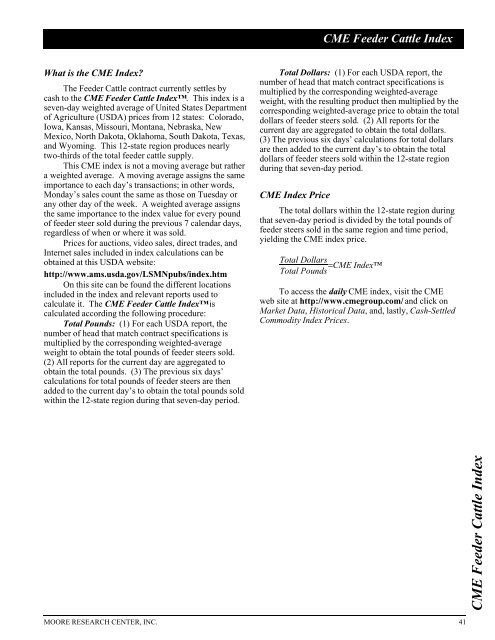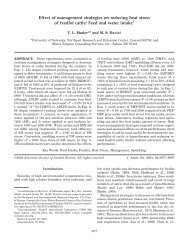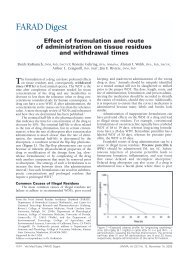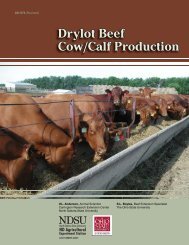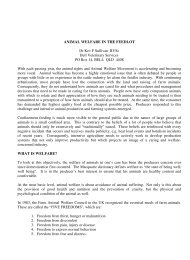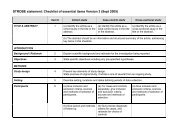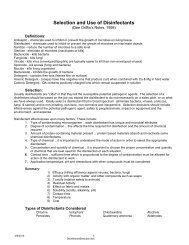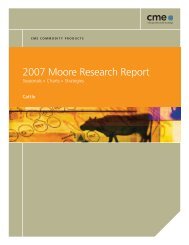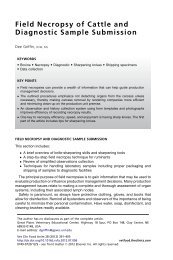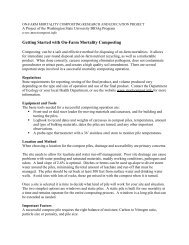Historical Live Cattle/Feeder Cattle Report - gpvec
Historical Live Cattle/Feeder Cattle Report - gpvec
Historical Live Cattle/Feeder Cattle Report - gpvec
Create successful ePaper yourself
Turn your PDF publications into a flip-book with our unique Google optimized e-Paper software.
What is the CME Index?<br />
The <strong>Feeder</strong> <strong>Cattle</strong> contract currently settles by<br />
cash to the CME <strong>Feeder</strong> <strong>Cattle</strong> Index. This index is a<br />
seven-day weighted average of United States Department<br />
of Agriculture (USDA) prices from 12 states: Colorado,<br />
Iowa, Kansas, Missouri, Montana, Nebraska, New<br />
Mexico, North Dakota, Oklahoma, South Dakota, Texas,<br />
and Wyoming. This 12-state region produces nearly<br />
two-thirds of the total feeder cattle supply.<br />
This CME index is not a moving average but rather<br />
a weighted average. A moving average assigns the same<br />
importance to each day’s transactions; in other words,<br />
Monday’s sales count the same as those on Tuesday or<br />
any other day of the week. A weighted average assigns<br />
the same importance to the index value for every pound<br />
of feeder steer sold during the previous 7 calendar days,<br />
regardless of when or where it was sold.<br />
Prices for auctions, video sales, direct trades, and<br />
Internet sales included in index calculations can be<br />
obtained at this USDA website:<br />
http://www.ams.usda.gov/LSMNpubs/index.htm<br />
On this site can be found the different locations<br />
included in the index and relevant reports used to<br />
calculate it. The CME <strong>Feeder</strong> <strong>Cattle</strong> Index is<br />
calculated according the following procedure:<br />
Total Pounds: (1) For each USDA report, the<br />
number of head that match contract specifications is<br />
multiplied by the corresponding weighted-average<br />
weight to obtain the total pounds of feeder steers sold.<br />
(2) All reports for the current day are aggregated to<br />
obtain the total pounds. (3) The previous six days’<br />
calculations for total pounds of feeder steers are then<br />
added to the current day’s to obtain the total pounds sold<br />
within the 12-state region during that seven-day period.<br />
Total Dollars: (1) For each USDA report, the<br />
number of head that match contract specifications is<br />
multiplied by the corresponding weighted-average<br />
weight, with the resulting product then multiplied by the<br />
corresponding weighted-average price to obtain the total<br />
dollars of feeder steers sold. (2) All reports for the<br />
current day are aggregated to obtain the total dollars.<br />
(3) The previous six days’ calculations for total dollars<br />
are then added to the current day’s to obtain the total<br />
dollars of feeder steers sold within the 12-state region<br />
during that seven-day period.<br />
CME Index Price<br />
CME <strong>Feeder</strong> <strong>Cattle</strong> Index<br />
The total dollars within the 12-state region during<br />
that seven-day period is divided by the total pounds of<br />
feeder steers sold in the same region and time period,<br />
yielding the CME index price.<br />
Total Dollars<br />
=CME Index<br />
Total Pounds<br />
To access the daily CME index, visit the CME<br />
web site at http://www.cmegroup.com/ and click on<br />
Market Data, <strong>Historical</strong> Data, and, lastly, Cash-Settled<br />
Commodity Index Prices.<br />
MOORE RESEARCH CENTER, INC. 41<br />
CME <strong>Feeder</strong> <strong>Cattle</strong> Index


